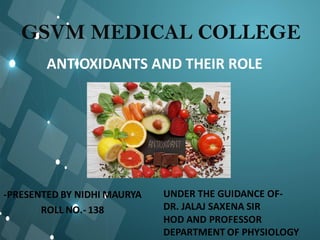
Physiology presentation
- 1. GSVM MEDICAL COLLEGE -PRESENTED BY NIDHI MAURYA ROLL NO.- 138 UNDER THE GUIDANCE OF- DR. JALAJ SAXENA SIR HOD AND PROFESSOR DEPARTMENT OF PHYSIOLOGY ANTIOXIDANTS AND THEIR ROLE
- 2. ANTIOXIDANTS To mitigate the harmful effects of free radicalsthe aerobic cellshave developedantioxidantdefence mechanism.A biologicalantioxidantdefined as substancethat significantlydelays or inhibits oxidation of substrate . Antioxidants may be consideredas scavengersof free radicals. The production of free radicalsand their neutralisationby antioxidantsis normal bodily process.
- 3. CLASSIFICATION OF ANTIOXIDANTS 1. . 1. Antioxidants according to their location a) Plasma antioxidants:–β-carotene, ascorbic acid, bilirubin, uric acid, ceruloplasmin, transferrin. b) Cell membrane antioxidants:- α-toco-pherol. c) Intracellular antioxidants:– superoxide dismutase, catalase, glutathione peroxidase.
- 4. 2) Antioxidants according to their nature and action i) Enzymatic antioxidantse.g. superoxide dismutase, catalase, glutathione peroxidase, glutathione reductase. ii) Non enzymatic antioxidants a) Nutrient antioxidants b) Metabolic antioxidant
- 5. THE ANTIOXIDANT ENZYME SYSTEM Superoxide dismutase First line of defense to protect cells from the injurious effect of superoxide Catalase Metabolises the hydrogen peroxide produced by SOD Glutathione peroxidase It detoxifies H2O2 to H2O , while reduced glutathione is converted to oxidised form. The reduced glutathione can be regenerated by glutathione reductase utilising NADPH.
- 6. NUTRIENT ANTIOXIDANT • Tocopherols [vitamin E] : vitamin E is a fat soluble , and among the tocopherols, alpha- tocopherol is biologically the most active. It is an antioxidant present in all cellular membranes, and protects against lipid peroxidation.Alpha tocopherol can directly act on oxyradicals and thus serves as an important chain breaking antioxidant.
- 7. • Ascorbic acid: It is a vitamin that participates in many metabolic reactions of the body and is important water soluble antioxidant in biological fluids. • Vitamin C efficiently scavenges free radicals and inhibits lipid peroxidation. • It also promotes the regeneration of alpha tocopherol from alpha toco-pheroxyl radical.
- 8. • Carotenoids : These are the natural compounds with lipophilic properties. About 500 different carotenoidshave been identified, among them beta carotene is the most important . • Beta carotene : Antioxidant under low partial pressure of O2. • Functions in associationwith vitamin C , E.
- 9. • Lycopene : • Fat soluble pigment • Responsible for colour to certain fruits and vegetables e.g. tomato. • Lutein and zeaxanthin impart yellow or green colour . These pigments can also serve as antioxidants.
- 10. • Selenium: • Essential trace element • Works with vitamin E in fighting free radicals • Required for function of an important antioxidant enzyme glutathione peroxidase. • Alpha lipoic acid: • It is vitamin like compound produced in body , besides the supply from plant and animal sources. • Recycling of other antioxidants such as ascorbic acid, alpha tocopherol and glutathione.
- 11. Caffeine: • Contains flavonoids[antioxidant] Other nutrient antioxidants • Proanthocynidinsof grape seeds • Catechins of green tea • Curcuminoids of turmeric • Quercetin of onion
- 12. METABOLIC ANTIOXIDANT Glutathione: • Reduced glutathione[GSH] act as key role in biological antioxidant enzyme system. • GSH and H2O2 are the twin substrate for glutathione peroxidase. • GSH gets regeneratedfrom oxidised glutathione [GS- SG] through the participation of glutathione reductase and NADPH. • Ability to synthesise GSH decreases as age advances ,and this have been implicated in certain diseases e.g.cataract
- 14. Some more metabolic antioxidants of biological importance • Uric acid : a powerful scavenger of singlet oxygen and OH- radicals. • Cerurloplasmin: inhibits iron and copper dependent lipid peroxidation • Transferrin: binds to iron and prevents iron catalysed free radical formation. • Albumin: can scavenge the free radicals formed on its surface . • Bilirubin: protects the albumin bound free fatty acids from peroxidation. • Haptoglobin: binds to free Hb and prevents the acceleration of lipid peroxidation.
- 15. DIETARY SUPPLEMENTATION OF ANTIOXIDANTS Free radicals damage biomolecules such as proteins, nucleic acids, lipids etc and are implicated in the causationand progress of several diseases [CHD , cancer , autoimmune diseases]. To counter the action of free radicals , many protective antioxidant nutrients (vit E and C, beta carotene, selenium ) are in use as dietary supplements.
- 17. Benefits of Antioxidants 1. Reduce the amount of free radicals in your body. 2. Reduce the risk of developing certain diseases such as; cancer, heart disease, stroke, cataracts, Parkinson's, Alzheimer's and arthritis. 3. Prevent direct cell damage caused by the chain reaction that free radicals initiate. 4. Reduce the signs of aging by preventing the oxidation of your skin cells. 5. Improves digestion. 6. Relieves asthma and allergy symptoms.
- 18. RISKS OF ANTIOXIDANTS • Even though there are many benefits to using antioxidants, too much can also cause harm. Too much antioxidant: • Increase the risk of mortality. • Increase the risk of cardiovascular disease. • Increased risk of hemorrhagic stroke. • The body produces its own antioxidants so adding too many external antioxidants can disrupt the homeostatic balance your body tries to maintain which leads to complications.
- 20. Special thanks to- Mahak Srivastava Anshika Gautam